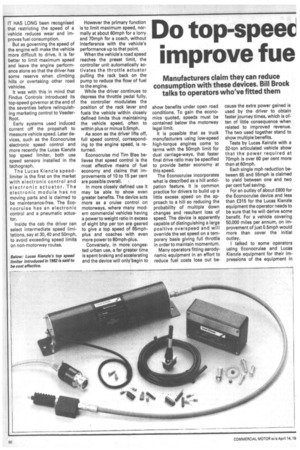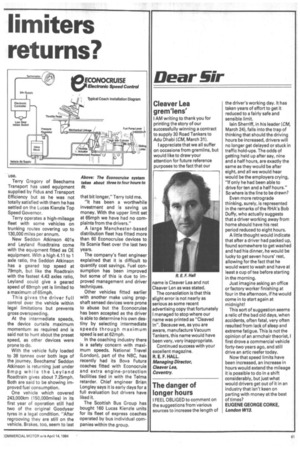Do toprispeet improve fue limiters returns?
Page 62

Page 63

If you've noticed an error in this article please click here to report it so we can fix it.
Manufacturers claim they can reduce consumption with these devices. Bill Brock talks to operators who've fitted them
IT HAS LONG been recognised that restricting the speed of a vehicle reduces wear and improves fuel consumption.
But as governing the speed of the engine will make the vehicle more difficult to drive, it is far better to limit maximum speed and leave the engine performance alone so that the driver has some reserve when climbing hills or overtaking other road vehicles.
It was with this in mind that Findus Controls introduced its top-speed governor at the end of the seventies before relinquishing marketing control to VeederRoot.
Early systems used induced current off the propshaft to measure vehicle speed. Later devices, such as the Econocruise electronic speed control and more recently the Lucas Kienzle top speed limiter, both use speed sensors installed in the tachograph.
The Lucas Kienzle speedlimiter is the first on the market with electronic control and electronic actuator. The electronic module has no moving parts and is claimed to be maintenance-free. The Econocruise has an electronic control and a pneumatic actuator.
Inside the cab the driver can select intermediate speed limitations, say at 30, 40 and 50mph, to avoid exceeding speed limits on non-motorway routes. However the primary function is to limit maximum speed, normally at about 60mph for a lorry and 70mph for a coach, without interference with the vehicle's performance up to that point.
When the vehicle's road speed reaches the preset limit, the controller unit automatically activates the throttle actuator pulling the rack back on the pump to reduce the flow of fuel to the engine.
While the driver continues to depress the throttle pedal fully, the controller modulates the position of the rack lever and fuels the vehicle within closely defined limits thus maintaining the vehicle speed, often to within plus or minus 0.5mph.
As soon as the driver lifts off, full speed control, corresponding to the engine speed, is returned.
Econocruise md Tim Blee believes that speed control is the most effective means of fuel economy and claims that improvements of 10 to 15 per cent are possible overall.
In more closely defined use it may be able to show even greater benefits. The device acts more as a cruise control on motorways, where many modern commercial vehicles having a power to weight ratio in excess of eight bhp per ton are geared to give a top speed of 65mphplus and coaches with even more power to 80mph-plus.
Conversely, in more congested urban use, a far greater time is spent braking and accelerating and the device will only begin to show benefits under open road conditions. To gain the economics quoted, speeds must be contained below the motorway legal limit.
It is possible that as truck manufacturers using low-speed high-torque engines come to terms with the 50mph limit for dual carriage-ways, that faster final drive ratio may be specified to provide better economy at this speed.
The Econocruise incorporates what is described as a hill anticipation feature. It is common practice for drivers to build up a little excess speed on the approach to a hill so reducing the probability of multiple down changes and resultant loss of speed. The device is apparently capable of distinguishing a large positive overspeed and will override the set speed on a temporary basis giving full throttle in order to maintain momentum.
Many operators fitting aerodynamic equipment in an effort to reduce fuel costs lose out be cause the extra power gained is used by the driver to obtain faster journey times, which is often of little consequence when related to improved revenue. The two used together stand to show multiple benefits.
Tests by Lucas Keinzle with a 32-ton articulated vehicle show that the power required at 70mph is over 60 per cent more than at 60mph.
Each single mph reduction between 65 and 55mph is claimed to yield between one and two per cent fuel saving.
For an outlay of about £600 for the Econocruise device and less than £315 for the Lucas Kienzle equipment the operator needs to be sure that he will derive some benefit. For a vehicle covering 50,000 miles per annum, on improvement of just 0.5mph would more than cover the initial outlay.
I talked to some operators using Econocruise and Lucas Kienzle equipment for their impressions of the equipment in use.
Terry Gregory of Beechams Transport has used equipment supplied by Fidus and Transport Efficiency but as he was not totally satisfied with them he has settled on the Lucas Kienzle Top Speed Governor.
Terry operates a high-mileage fleet with some vehicles on trunking routes covering up to 130,000 miles per annum.
New Seddon Atkinson 401s and Leyland Roadtrains come with the equipment fitted as OE equipment. With a high 4.11 to 1 axle ratio, the Seddon Atkinson has a geared top speed at 79mph, but like the Roadtrain with the fastest 4.43 axles ratio, Leyland could give a geared speed of 69mph yet is limited to a maximum of 65mph.
This gives the driver full control over the vehicle within legal limitations but prevents gross overspeeding.
At the intermediate speeds, the device curtails maximum momentum as required and is said not to hunt about the preset speed, as other devices were prone to do.
With the vehicle fully loaded to 38 tonnes over both legs of the journey, Beechams' Seddon Atkinson is returning just under 8mpg while the Leyland Roadtrain gives about 7.25mph. Both are said to be showing improved fuel consumption.
One vehicle which covered 243,000km (150,000miles) in its first year of operation still had two of the original Goodyear tyres in a legal condition. "After regrooving they are still on the vehicle. Brakes, too, seem to last that bit longer," Terry told me.
"It has been a worthwhile investment and is saving us money. With the upper limit set at 65mph we have had no complaints from the drivers."
A large Manchester-based distribution fleet has fitted more than 60 Econocruise devices to its Scania fleet over the last two years.
The company's fleet engineer explained that it is difficult to quantify cost savings. Fuel consumption has been improved but some of this is due to improved management and driver techniques.
Other vehicles fitted earlier with another make using propshaft sensed devices were prone to abuse but the Econocruise has been accepted as the driver is able to determine his own destiny by selecting intermediate speeds through maximum speed is set at 62mph.
In the coaching industry there is a safety concern with maximum speeds. National Travel (London), part of the NBC, has recently had its Bova Futura coaches fitted with Econocruie and extra engine-protection facilities tied in with the Telma retarder. Chief engineer Brian Longley says it is early days for a full evaluation but drivers have liked it.
The Scottish Bus Group has bought 160 Lucas Kienzle units for its fleet of express coaches operated by bus individual companies within the group.




























































































